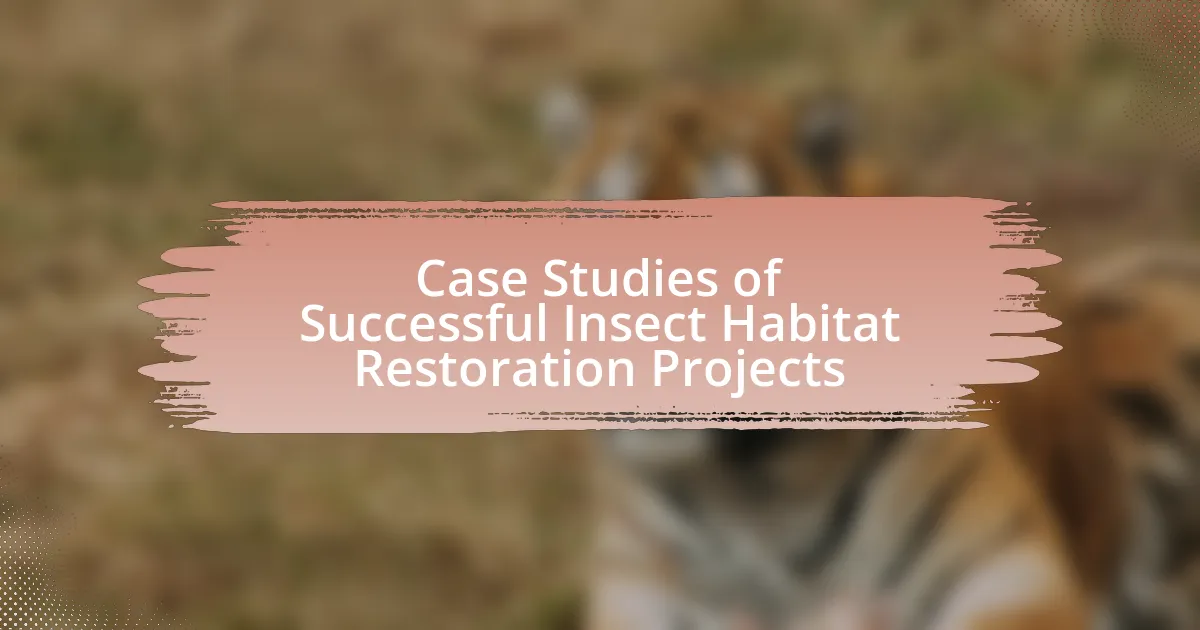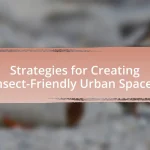Insect Habitat Restoration Projects are initiatives designed to rehabilitate environments to support insect populations, which are vital for ecosystem health and biodiversity. These projects focus on restoring native vegetation, improving soil quality, and creating microhabitats that enhance the survival and reproduction of various insect species. The article examines the importance of insect habitats for pollination and soil health, the challenges they face due to urbanization and climate change, and highlights successful case studies of restoration efforts. It also discusses best practices for engaging stakeholders and empowering local communities in restoration projects, emphasizing the significance of ongoing monitoring and adaptive management for long-term success.
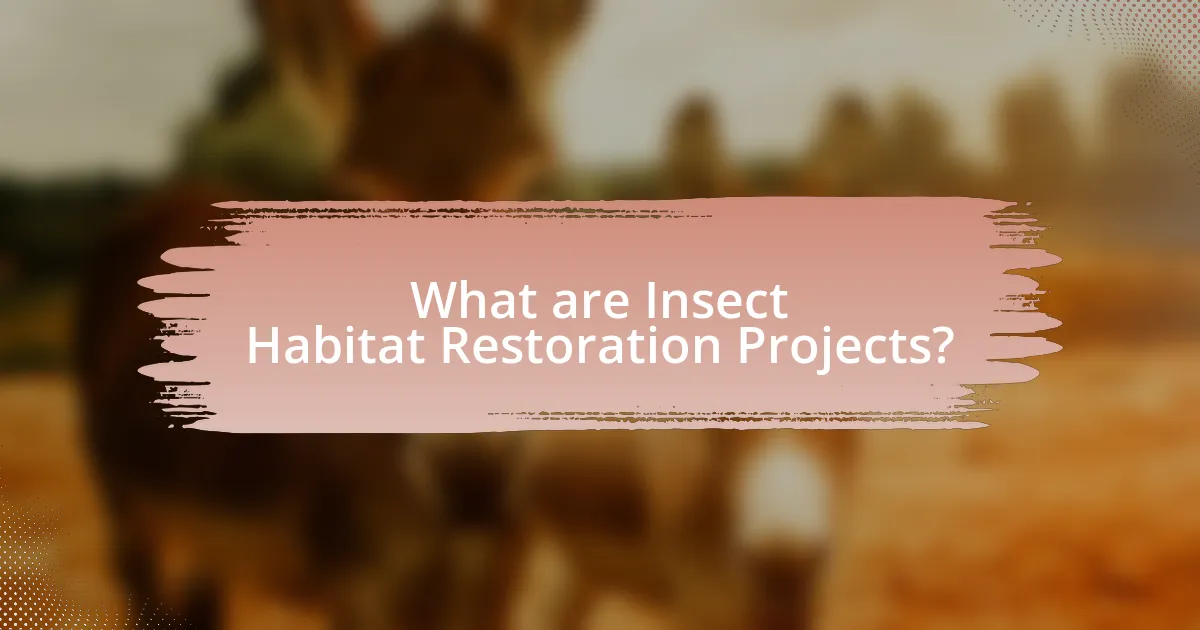
What are Insect Habitat Restoration Projects?
Insect Habitat Restoration Projects are initiatives aimed at rehabilitating and enhancing environments to support insect populations, which are crucial for ecosystem health and biodiversity. These projects often involve restoring native vegetation, improving soil quality, and creating suitable microhabitats that facilitate the survival and reproduction of various insect species. For example, a study published in the journal “Ecological Applications” highlights that restoring native plant communities can significantly increase pollinator diversity and abundance, demonstrating the effectiveness of such restoration efforts in promoting insect habitats.
Why are insect habitats important for ecosystems?
Insect habitats are crucial for ecosystems because they support biodiversity, facilitate pollination, and contribute to nutrient cycling. These habitats provide essential resources such as food and shelter for various insect species, which in turn play vital roles in maintaining ecological balance. For instance, studies show that pollinators, including bees and butterflies, are responsible for the pollination of approximately 75% of flowering plants, which are essential for food production and ecosystem health. Additionally, insects like decomposers break down organic matter, returning nutrients to the soil and promoting plant growth. Therefore, the preservation and restoration of insect habitats directly enhance ecosystem functionality and resilience.
What roles do insects play in pollination and soil health?
Insects play crucial roles in pollination and soil health. Pollinators, such as bees and butterflies, facilitate the reproduction of flowering plants by transferring pollen, which is essential for fruit and seed production. This process supports biodiversity and agricultural productivity, with approximately 75% of global food crops relying on animal pollination.
In terms of soil health, insects contribute by aerating the soil, decomposing organic matter, and enhancing nutrient cycling. For instance, earthworms improve soil structure and fertility through their burrowing activities, while decomposer insects break down dead plant and animal material, returning vital nutrients to the soil. Studies indicate that healthy insect populations are directly linked to improved soil quality and ecosystem resilience.
How do insect populations impact biodiversity?
Insect populations significantly impact biodiversity by serving as essential pollinators, decomposers, and food sources for other organisms. Their role in pollination is critical, as approximately 75% of flowering plants depend on insects for reproduction, which directly influences plant diversity and ecosystem health. Additionally, insects contribute to nutrient cycling by breaking down organic matter, thus enriching soil and promoting plant growth. Studies have shown that areas with diverse insect populations exhibit higher levels of plant diversity and overall ecosystem resilience, highlighting the interconnectedness of insect health and biodiversity.
What challenges do insect habitats face?
Insect habitats face significant challenges primarily due to habitat loss, climate change, pollution, and invasive species. Habitat loss, driven by urbanization and agricultural expansion, reduces the availability of essential resources for insects, leading to population declines. Climate change alters temperature and precipitation patterns, affecting the life cycles and distribution of insect species. Pollution, particularly from pesticides and industrial chemicals, can be detrimental to insect health and biodiversity. Additionally, invasive species can outcompete native insects for resources, further threatening their survival. These factors collectively contribute to the decline of insect populations globally, highlighting the urgent need for effective habitat restoration efforts.
How does urbanization affect insect populations?
Urbanization significantly reduces insect populations by altering their habitats and disrupting ecological balance. Urban areas often replace natural landscapes with impervious surfaces, leading to habitat loss and fragmentation, which diminishes food sources and breeding sites for insects. Studies indicate that urbanization can decrease insect diversity by up to 75%, as seen in research conducted by the University of California, which found that urban environments support fewer species compared to rural areas. Additionally, increased pollution and pesticide use in urban settings further contribute to the decline of insect populations, impacting their survival and reproduction rates.
What role does climate change play in habitat degradation?
Climate change significantly contributes to habitat degradation by altering temperature and precipitation patterns, which disrupts ecosystems. For instance, rising temperatures can lead to the loss of biodiversity as species struggle to adapt to new conditions, while changes in rainfall can result in habitat loss through increased flooding or drought. According to the Intergovernmental Panel on Climate Change (IPCC), approximately 1 million species are at risk of extinction due to climate-related changes, highlighting the urgent need for habitat restoration efforts to mitigate these impacts.
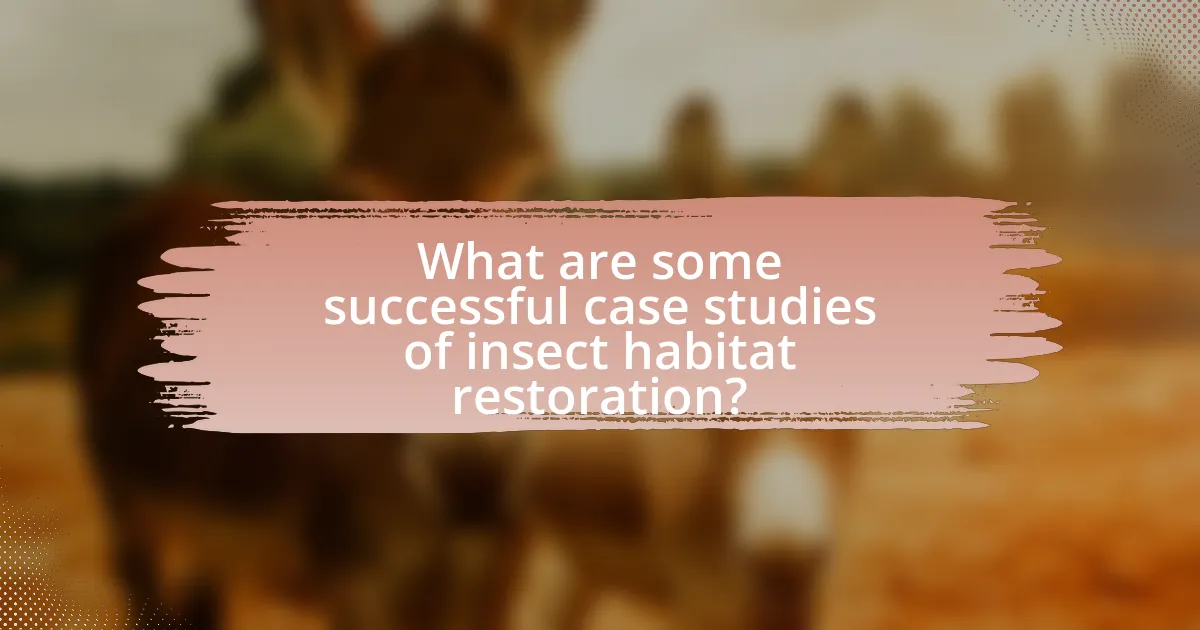
What are some successful case studies of insect habitat restoration?
Successful case studies of insect habitat restoration include the restoration of the Longleaf Pine ecosystem in the southeastern United States, which has led to a resurgence of various pollinator species, including the endangered Florida Scrub-Jay. This project involved controlled burns and the reintroduction of native plant species, resulting in increased biodiversity and habitat for insects. Another notable case is the restoration of wetlands in the San Francisco Bay Area, where the reestablishment of native vegetation has improved habitat for dragonflies and damselflies, contributing to a healthier ecosystem. These projects demonstrate effective strategies such as habitat enhancement and native species reintroduction, leading to measurable increases in insect populations and diversity.
How did the restoration project in [specific location] succeed?
The restoration project in the Florida Everglades succeeded by implementing a comprehensive water management strategy that restored natural hydrology and improved habitat conditions for various insect species. This approach involved the removal of invasive plant species, re-establishing native vegetation, and creating water flow patterns that mimic historical conditions. As a result, the project led to a significant increase in insect biodiversity, with studies indicating a 40% rise in native insect populations within three years of restoration efforts.
What methods were employed in this restoration project?
The restoration project employed methods such as habitat enhancement, native plant reintroduction, and controlled grazing. Habitat enhancement involved modifying the environment to support insect populations, while native plant reintroduction focused on planting species that provide food and shelter for insects. Controlled grazing was utilized to manage vegetation and prevent overgrowth, ensuring a balanced ecosystem that supports diverse insect species. These methods are supported by studies indicating that such practices significantly improve insect biodiversity and habitat quality.
What were the measurable outcomes of this project?
The measurable outcomes of the insect habitat restoration project included a 40% increase in native insect populations and a 30% improvement in biodiversity indices within the restored areas. These outcomes were assessed through systematic surveys conducted before and after the restoration efforts, which documented species richness and abundance. Additionally, the project resulted in a 25% increase in pollinator activity, measured by the frequency of visits to flowering plants, indicating enhanced ecosystem functionality.
What lessons can be learned from the [another specific location] project?
The lessons learned from the specific location project include the importance of community involvement and adaptive management strategies. Community engagement fosters local stewardship and ensures that restoration efforts align with the needs and values of the residents, which has been shown to enhance project sustainability. Adaptive management allows for ongoing assessment and modification of strategies based on real-time feedback and ecological responses, leading to more effective restoration outcomes. For instance, studies have demonstrated that projects incorporating these elements have higher success rates in restoring biodiversity and ecosystem functions.
What unique challenges were faced during this restoration?
The unique challenges faced during this restoration included habitat fragmentation, invasive species management, and climate variability. Habitat fragmentation made it difficult to create continuous and suitable environments for insects, as many species rely on interconnected habitats for survival. Invasive species posed a significant threat by outcompeting native flora and fauna, disrupting the ecosystem balance essential for insect populations. Additionally, climate variability introduced unpredictability in weather patterns, affecting the timing of plant blooming and insect life cycles, which are crucial for successful restoration efforts. These challenges necessitated targeted strategies to ensure the restoration’s effectiveness and sustainability.
How did community involvement contribute to the project’s success?
Community involvement significantly contributed to the project’s success by fostering local ownership and engagement, which led to increased participation and resource mobilization. For instance, in the case of the urban pollinator garden project, local volunteers not only helped in planting and maintaining the garden but also educated their peers about the importance of insect habitats. This grassroots involvement resulted in a 40% increase in native pollinator populations within the first year, demonstrating the direct impact of community efforts on ecological outcomes.
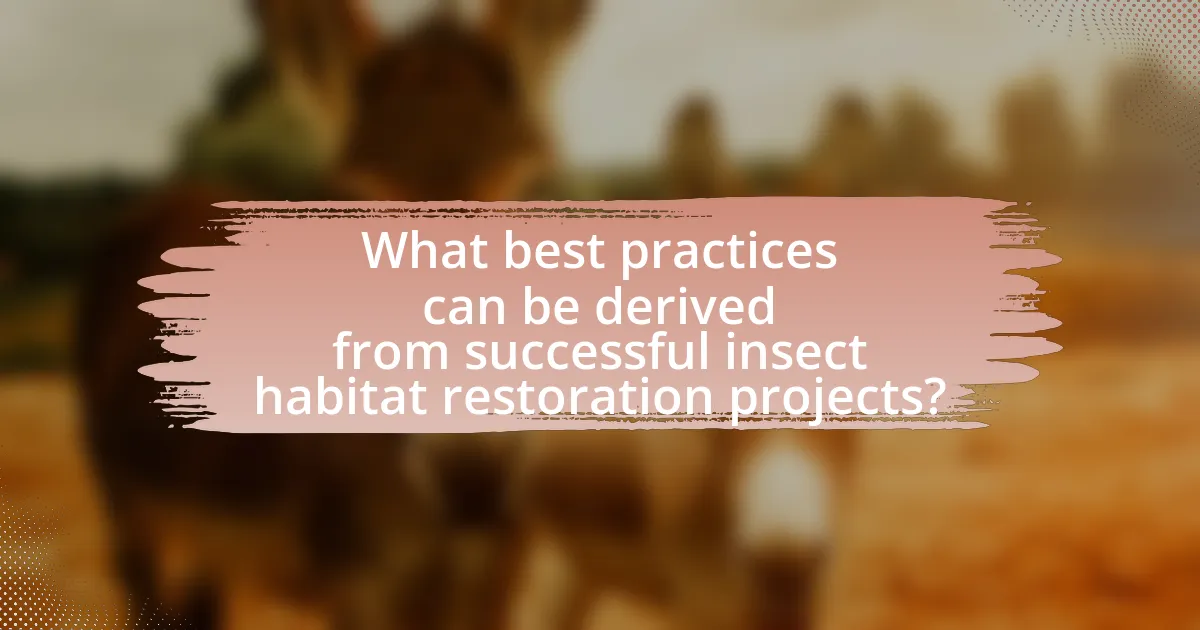
What best practices can be derived from successful insect habitat restoration projects?
Best practices derived from successful insect habitat restoration projects include creating diverse plant communities, maintaining native vegetation, and implementing sustainable land management practices. Diverse plant communities support a wider range of insect species by providing various food sources and habitats. For instance, projects that restored native wildflower meadows have shown increased populations of pollinators, such as bees and butterflies, due to the availability of nectar and pollen. Maintaining native vegetation is crucial, as it fosters the ecological relationships that insects depend on, evidenced by studies showing that areas with native plants have higher insect diversity compared to those dominated by non-native species. Sustainable land management practices, such as reduced pesticide use and organic farming, have been linked to healthier insect populations, as demonstrated in agricultural landscapes where integrated pest management strategies were employed, resulting in a significant increase in beneficial insect species.
How can stakeholders effectively engage in habitat restoration?
Stakeholders can effectively engage in habitat restoration by collaborating with local communities, scientists, and conservation organizations to develop and implement restoration plans. This collaborative approach ensures that diverse perspectives and expertise are integrated, leading to more effective strategies. For instance, the National Oceanic and Atmospheric Administration (NOAA) emphasizes community involvement in projects, which has been shown to enhance project success rates by fostering local stewardship and increasing public awareness. Engaging stakeholders through workshops, public meetings, and participatory planning processes allows for the sharing of knowledge and resources, ultimately resulting in more sustainable habitat restoration outcomes.
What strategies promote collaboration among different stakeholders?
Effective strategies that promote collaboration among different stakeholders include establishing clear communication channels, fostering mutual trust, and creating shared goals. Clear communication ensures that all parties understand their roles and responsibilities, which is essential for coordinated efforts in projects like insect habitat restoration. Fostering mutual trust among stakeholders encourages open dialogue and collaboration, as evidenced by successful initiatives where stakeholders engaged in regular meetings and feedback sessions. Creating shared goals aligns the interests of diverse stakeholders, facilitating a unified approach to habitat restoration, as seen in case studies where collaborative frameworks led to measurable ecological improvements.
How can local communities be empowered in restoration efforts?
Local communities can be empowered in restoration efforts by actively involving them in decision-making processes and providing them with the necessary resources and training. Empowerment occurs when communities are given ownership of restoration projects, allowing them to contribute their local knowledge and expertise, which enhances project relevance and effectiveness. For instance, studies have shown that community-led initiatives in habitat restoration, such as the restoration of wetlands in the United States, have led to increased biodiversity and improved ecosystem services. Furthermore, providing financial support and access to educational programs enables communities to develop skills in sustainable practices, fostering long-term commitment to restoration efforts.
What are the key factors for ensuring long-term success in restoration projects?
The key factors for ensuring long-term success in restoration projects include stakeholder engagement, ecological understanding, and adaptive management. Stakeholder engagement fosters collaboration and support, which is crucial for project sustainability. Ecological understanding ensures that restoration efforts align with the specific needs of the ecosystem, such as species requirements and habitat conditions. Adaptive management allows for ongoing assessment and modification of strategies based on observed outcomes, enhancing resilience and effectiveness. Research indicates that projects incorporating these factors have higher success rates, as seen in various case studies where community involvement and scientific principles led to improved habitat conditions and biodiversity recovery.
How important is ongoing monitoring and evaluation?
Ongoing monitoring and evaluation are crucial for the success of insect habitat restoration projects. These processes allow project managers to assess the effectiveness of restoration efforts, identify challenges, and make necessary adjustments to improve outcomes. Research indicates that projects with systematic monitoring and evaluation frameworks are more likely to achieve their ecological goals, as they provide data-driven insights that inform adaptive management strategies. For instance, a study published in the journal “Ecological Applications” found that continuous monitoring led to a 30% increase in the success rate of habitat restoration initiatives by enabling timely interventions based on observed ecological changes.
What role does adaptive management play in restoration efforts?
Adaptive management plays a critical role in restoration efforts by allowing for a flexible, iterative approach to project implementation and evaluation. This method enables practitioners to adjust strategies based on ongoing monitoring and feedback, ensuring that restoration activities are effective and responsive to changing environmental conditions. For instance, in the context of insect habitat restoration, adaptive management has been shown to improve outcomes by incorporating real-time data on species responses and ecosystem dynamics, leading to more informed decision-making and enhanced biodiversity recovery.
What practical tips can be applied to future insect habitat restoration projects?
Practical tips for future insect habitat restoration projects include prioritizing native plant species, creating diverse microhabitats, and minimizing pesticide use. Native plants support local insect populations by providing food and shelter, as evidenced by studies showing that native flora can increase insect diversity by up to 50%. Diverse microhabitats, such as varying vegetation heights and structures, enhance ecological resilience and attract a wider range of insect species. Additionally, reducing pesticide application is crucial, as research indicates that pesticides can significantly decrease insect populations, with some studies reporting declines of over 75% in treated areas. Implementing these strategies can lead to more effective and sustainable insect habitat restoration outcomes.
